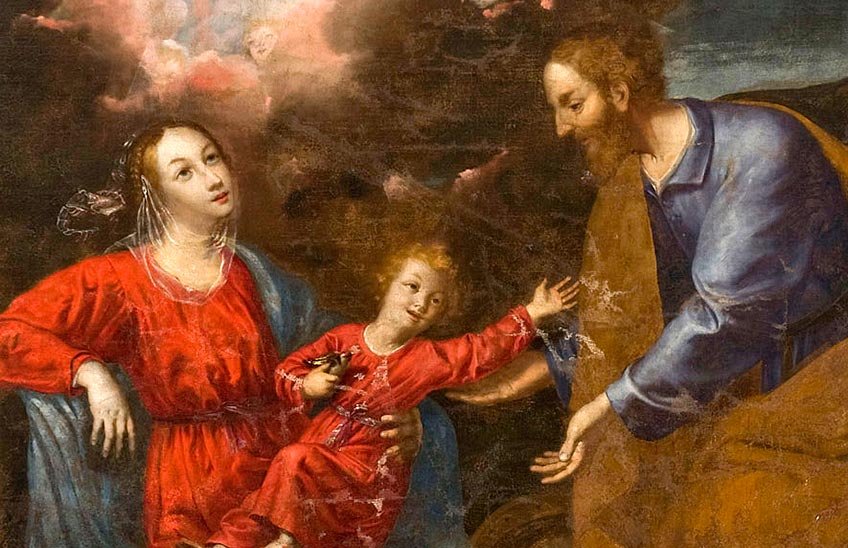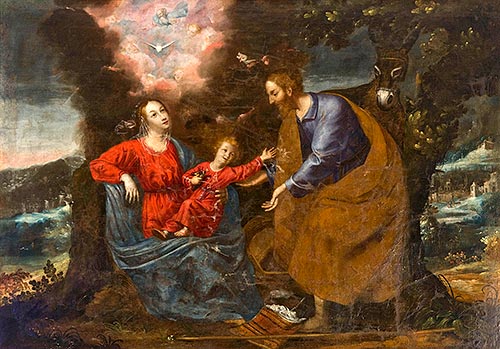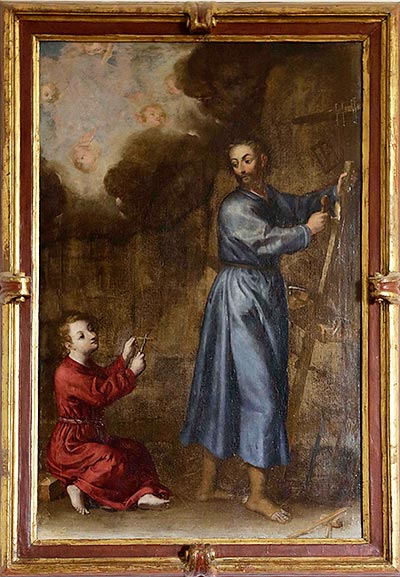Two canvases from Leire's secular heritage

PhotoCedit/Detailof the canvas of the Rest in the Flight into Egypt from the monastery of Leire, 1637.
Very few of the paintings that adorned the rooms of the monastery have survived. Among them were the portraits of kings. Specifically, the inventory of 1809 lists "ten portraits of princes and kings" at conference room in the abbey palace and "two portraits of king and queen" in the dormitory of the same place. However, the paintings of St. Bernard and St. Benedict in the sacristy and St. Virila in the church have come down to us, remarkable for their quality and iconographic rarity. There are also two canvases hanging on the walls of the refectory, which are the subject of this text.
According to oral tradition, both belonged to an altarpiece dedicated to Saint Joseph. Only one is signed with a very lost registration , of which we recently made a reading. It is a canvas of the Rest at the Flight into Egypt, which now presides over the monastic refectory. The topic is distinctly Counter-Reformation, full of intimacy and tenderness. Its interpretation gave artists the opportunity to depict trees, ruins, clouds, blue distances and luminous rivers, in a context in which, as E. Mâle observed, austerity seemed to have banished the landscape from religious art, so that nothing could distract from the piety of contemplating sacred scenes.

Rest in the Flight into Egypt in the monastery of Leire, 1637. Photo J. L. Larrión
An analysis of the registration provides at least two clues, the Latin name of Saragossa, where the canvas was painted in 1637, and the surname Aranegui. The identification of the latter with Fray Juan de Arranegui, procurator of the monastery and its secretary that same year of 1637, does not seem to leave any doubt as to the monk's identity. As for the author, the last letters before the f(fecit) and the ending of the author's surname , specifically "van", lead us to the painter Juan Galván (1596-1658), a native of Luesia who settled in the Aragonese capital. The formal analysis of the composition and its colouring, as well as the mastery of chiaroscuro and its dimensions, fit in with the works of the aforementioned painter, whom his fellow countryman Jusepe Martínez refers to as a fan of "large paintings in the Italian manner". After a stay in Rome, he returned to the Aragonese capital, where he became painter to the provincial council of that kingdom. Galván gave great prominence to the figures of the Holy Family in the foreground, emphasising the red of Mary's clothes and the Child, who, incidentally, is playing with a goldfinch. Thematically, it is also a double Trinity because, above the Holy Family, we find God the Father and the dove of the Paraclete. The large landscape with its many details is, as we have already noted, a real protagonist in the whole.
Among the contemporary paintings of this large canvas, which belongs to the above-mentioned altarpiece of Saint Joseph, is the one in the Nazareth Workshop, without the presence of the Virgin Mary. It is of interest B because it can be read in the light of some contemporary texts that present the Child as in the painting: picking up splinters and joining two of them together in the form of a cross. An example of this is the play by the Valencian playwright Guillén de Castro El mejor esposo, composed between 1618 and 1625, in which there is a moment in which Saint Joseph sends his officers away and is left alone in the workshop with the young Jesus. While they are sawing and planing one of the boards to make a door, two small splinters cross each other by chance and form a cross, and seeing the timbers like this, Jesus quickly takes them and recites some allusive verses, which read as follows: "How well they look like this / How glad I am of hair / For by my divine being / So important they will be / That in this form in which they are / Gates of heaven they are to be / Through my pious blood / For me on them shed / Blessed cross, my bride, / For on that blissful day / You will be my royal throne / And the immortal Chair / Where I suffer, / Of my love I will read / The heavenly doctrine."

Nazareth workshop in the monastery of Leire. Photo J. L. Larrión
To find out more
FERNÁNDEZ GRACIA, R., "Patrimonio e identidad (17). Orígenes e hipótesis sobre el patrimonio mueble de Leire", Diario de Navarra, 4 October 2019, pp. 64-65.
MÂLE, E., The Baroque. Religious art of the 17th century. Italy, France, Spain, Flanders, Madrid, meeting, 1985.
MARTÍNEZ, J., Discursos practicables del nobilísimo arte de la pintura, Torrejón de Ardoz, Akal, 1988.
RODRÍGUEZ, GUTIÉRREZ DE CEBALLOS, A., "Iconografía y Contrarreforma. A purpose de algunas pinturas de Zurbarán", Cuadernos de Arte e Iconografía, t. 4, II (1989), pp. 97-105.
